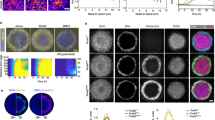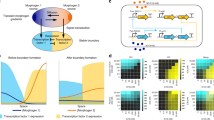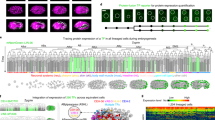Abstract
Morphogens are signal molecules presumed to exist in embryos and to be involved in establishing the spatial pattern of cells during development. Differentiation inducing factor (DIF) has the properties of a morphogen required for producing the prestalk/prespore pattern in the aggregate formed by cells of the slime mould Dictyostelium in response to starvation. DIF-1, the major bioactive species after purification, has now been identified using a combined microchemical, spectroscopic and synthetic approach. The structure is defined as 1-(3,5-dichloro-2,6-dihydroxy-4-methoxy-phenyl)-1-hexanone, and represents a new class of effector molecule. The availability of relatively large quantities of synthetic and isotopically labelled materials should now allow progress towards a detailed understanding of the pattern-forming processes in Dictyostelium development.
This is a preview of subscription content, access via your institution
Access options
Subscribe to this journal
Receive 51 print issues and online access
$199.00 per year
only $3.90 per issue
Buy this article
- Purchase on Springer Link
- Instant access to full article PDF
Prices may be subject to local taxes which are calculated during checkout
Similar content being viewed by others
References
1. Wolpert, L. J. theor. Biol. 25, 1–47 (1969). 2. Gierer, A. & Meinhardt, H. Kybernetik 12, 30–39 (1972). 3. Anderson, K. V. & Nusslein–Volhard, C. Nature 311, 223–227 (1984). 4. Frohnhofer, H. G. & Nusslein–Volhard, C. Nature 324, 120–125 (1986). 5. Wharton, K. A., Johansen, K. M., Xu, T. & Artavanis–Tsakonas, S. Cell 43, 567–581 (1985). 6. Macdonald, P. M. & Struhl, G. Nature 324, 537–545 (1986). 7. Greenwald, I. Cell 43, 583–590 (1985). 8. Schaller, H. C. & Bodenmuller, H. Proc. natn. Acad. Sci. U.S.A. 78, 7000–7004 (1981). 9. Maden, M. Nature 295, 672–675 (1982). 10. Tickle, C., Alberts, B., Wolpert, L. & Lee, J. Nature 296, 564–566 (1982). 11. Smith, J. C. Development 99, 3–14 (1987). 12. Town, C. D., Gross, J. D. & Kay, R. R. Nature 262, 717–719 (1976). 13. Town, C. D. & Stanford, E. Proc. natn. Acad. Sci. U.S.A. 76, 308–312 (1979). 14. Brookman, J. J., Town, C. D., Jermyn, K. A. & Kay, R. R. Devl Biol. 91, 191–196 (1982). 15. Kay, R. R., Dhokia, B. & Jermyn, K. A. Eur. J. Biochem. 136, 51–56 (1983). 16. Morris, H. R., Taylor, G. W., Piper, P. J. & Tippins, J. R. Nature 285, 104–106 (1980). 17. Beloff–Chain, A., Motion, J., Dunmore, S., Taylor, G. W. & Morris, H. R. Nature 301, 255–258 (1983). 18. Kay, R. R. & Jermyn, K. A. Nature 303, 242–244 (1983). 19. Williams, J. G. et al Cell 49, 185–192 (1987). 20. Kopachik, W., Oohata, A., Dhokia, B., Brookman, J. J. & Kay, R. R. Cell 33,397–403 (1983). 21. Brookman, J. J., Jermyn, K. A. & Kay, R. R. Development 100, 119–124 (1987). 22. Gross, J. D., Bradbury, J., Kay, R. R. & Peacey, M. J. Nature 303, 244–245 (1983). 23. Sobolewski, A., Neave, N. & Weeks, G. Differentiation 25, 93–100 (1983).
Author information
Authors and Affiliations
Rights and permissions
About this article
Cite this article
Morris, H., Taylor, G., Masento, M. et al. Chemical structure of the morphogen differentiation inducing factor from Dictyostelium discoideum. Nature 328, 811–814 (1987). https://doi.org/10.1038/328811a0
Received:
Accepted:
Issue Date:
DOI: https://doi.org/10.1038/328811a0
This article is cited by
-
Emerging roles for diguanylate cyclase during the evolution of soma in dictyostelia
BMC Ecology and Evolution (2023)
-
Engineering the amoeba Dictyostelium discoideum for biosynthesis of a cannabinoid precursor and other polyketides
Nature Biotechnology (2022)
-
DIF-1 inhibits growth and metastasis of triple-negative breast cancer through AMPK-mediated inhibition of the mTORC1-S6K signaling pathway
Oncogene (2021)
-
Assessing the robustness of decentralized gathering: a multi-agent approach on micro-biological systems
Swarm Intelligence (2020)
-
An individual-level selection model for the apparent altruism exhibited by cellular slime moulds
Journal of Biosciences (2018)
Comments
By submitting a comment you agree to abide by our Terms and Community Guidelines. If you find something abusive or that does not comply with our terms or guidelines please flag it as inappropriate.



